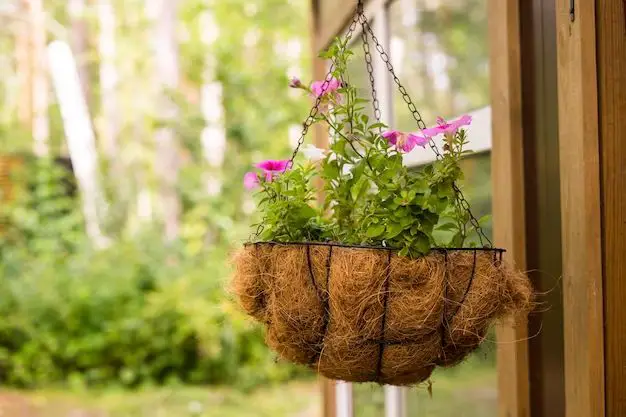Hanging baskets are a great way to decorate outdoor spaces with beautiful flowers and plants. However, filling the bottom of hanging baskets properly is important to help the plants thrive. There are a few key things to put in the bottom of hanging baskets when planting.
Page Contents
Use a liner
It’s important to line hanging baskets before filling them with soil and plants. The liner helps keep the soil from falling out of the holes in the bottom of the basket. Plastic basket liners can be purchased, but you can also make your own by placing coffee filters, shredded moss, or landscape fabric in the bottom of the planter.
Add drainage material
Proper drainage is crucial for healthy hanging plants. The bottom few inches of a hanging basket should be filled with coarse material to allow excess water to drain out. Good options include:
- Pebbles
- Broken terracotta shards
- Pine bark nuggets
- Coconut coir chunks
- Polystyrene peanuts
- Pumice
This layer of coarse material will help prevent soil and roots from getting waterlogged. The drainage layer also helps prevent soil from leaking out of the basket.
Use a light potting mix
The key to thriving hanging basket plants is using a very porous, lightweight potting mix that drains well. Regular garden soil is too dense and will stay overly wet. Make your own mix by combining:
- 1 part peat moss
- 1 part perlite
- 1 part vermiculite or coconut coir
You can also purchase premixed potting soils or coco coir fiber liners formulated for hanging baskets. The mix should contain compost or fertilizer to nourish plants.
Include water-retaining polymers
Hanging plants are prone to drying out fast, especially during hot weather. Adding moisture-absorbing polymers to the soil mix can help lock in water. Two types of polymers to try are:
- Water storing crystals – These super-absorbent polymers swell up and slowly release moisture back to plant roots when the soil dries out.
- Water retaining gels – Gel beads mixed into the soil absorb and hold a large volume of water that keeps plant roots hydrated.
Follow package instructions for how much to add – a little goes a long way. Rehydrate and fluff up the polymers periodically.
Add a slow-release fertilizer
Using a granular, slow-release fertilizer when planting hanging baskets provides nutrients for several months. This prevents having to frequently feed plants with liquid fertilizer later on. Extended release options to mix in include:
- Osmocote fertilizer beads
- Bio-tone starter fertilizer
- Schultz 2-7-7 granules
Another option is to blend in a handful or two of compost, worm castings, or manure into the soil for organic nutrients.
Plant densely
Hanging baskets look best and grow well when planted densely. Follow these tips:
- Aim for at least 3-5 plants per basket.
- Plant fast-growing vines and trailers that will spill over the sides.
- Surround centerpiece plants with lower-growing filler plants.
- Choose plants with similar light and water needs.
- Use plants that cascade at different heights.
Crowding plants together reduces soil drying out. It also creates a lush, full look faster than spacing plants out.
Care for plants properly
Caring for hanging basket plants properly ensures they thrive all season:
- Water thoroughly – Check soil daily and water when top few inches feel dry. Water slowly until it drips from the bottom drainage holes.
- Fertilize regularly – Feed plants with a diluted liquid fertilizer solution every 2-3 weeks.
- Prune and deadhead – Pinch back, trim, and remove spent blooms to encourage more flowers.
- Monitor for pests – Watch for common hanging basket invaders like aphids, mealybugs, spider mites, and whitefly.
Moving hanging baskets to partial shade during extremely hot weather will help prevent wilting.
Conclusion
Using the right materials when planting hanging baskets is important for growing lush, thriving plants all season long. Lining baskets, adding drainage layers, using light soil mixes, and incorporating polymers and fertilizer sets plants up for success. Combining trailing and fuller plants creates beautiful cascading displays. And caring for baskets properly by watering, fertilizing, pruning, and monitoring pests keeps plants looking their best.
